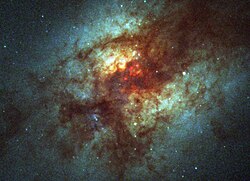阿尔普220
| Arp 220 | |
|---|---|
 | |
| 观测资料(J2000 历元) | |
| 星座 | 巨蛇座 |
| 赤经 | 15h 34m 57.1s[1] |
| 赤纬 | +23° 30′ 11″[1] |
| 红移 | 5434 ± 7 km/s[1] |
| 距离 | 250 Mly (77 Mpc)[来源请求] |
| 视星等 (V) | 13.9[1] |
| 特征 | |
| 类型 | S?[1] |
| 角直径 (V) | 1′.5 x 1′.2[1] |
| 其他名称 | |
| IC 1127,[1] IC 4553,[1] UGC 9913,[1] PGC 55497[1] | |
阿尔普220(Arp 220)是两个星系相互碰撞后合并中的天体,距离地球约2.5亿光年,位于巨蛇座。名称来自它是霍尔顿·阿尔普编的《特殊星系图集》中的第220个天体。
概要[编辑]

阿尔普220是距离地球最近的极亮红外星系。红外天文卫星发现它的辐射波段主要是在远红外线[2],因此常被认为是极亮红外星系的原型,并且是许多相关研究的主题。阿尔普220大部分的能量输出被认为是大量恒星形成的结果,并且这现象可能是因为两个较小星系合并引发。2002到2007年哈勃空间望远镜对阿尔普220使用先进巡天照相机进行可见光波段观测,以及近红外线照相机和多目标分光仪进行红外线波段观测,在它的中心部位发现了超过200个巨大星团。其中最巨大的星团内所含物质约有1000万倍太阳质量[3]。钱德拉X射线天文台和XMM-牛顿卫星以X射线观测的结果显示阿尔普220的核心可能存在活动星系核,这产生了活动星系核和星系合并之间关联性的有趣问题。一般认为既然星系合并常造成星暴,也可能产生驱动活动星系核的特大质量黑洞[4][5]。
天文学家使用詹姆斯·克拉克·麦克斯韦望远镜搭载的亚毫米波通用测辐射计阵列进行次毫米波段巡天观测,结果意外发现跟阿尔普220一样的亮红外星系相当多[6]。天文学家对阿尔普220和其他相对距离地球较近的极亮红外星系都进行了大量研究。
阿雷西博天文台的天文学家对阿尔普220进行观测发现该星系内有有机分子存在[7]。
阿尔普220内至少有两个明亮的激微波源,其中一个是 OH 分子,另一个则是水分子激微波[8]。
2011年10月,天文学家破纪录地在阿尔普220内同时发现了7颗超新星[9][10][11]。
参考资料[编辑]
- ^ 1.00 1.01 1.02 1.03 1.04 1.05 1.06 1.07 1.08 1.09 NASA/IPAC Extragalactic Database. Results for Arp 220. [2006-12-07]. (原始内容存档于2018-12-25).
- ^ IRAS exposes a remarkable infrared galaxy , Physics Today, 37, part no 8, 18-20 (1984)
- ^ Hubble Eyes Star Birth in the Extreme. [2006-10-16]. (原始内容存档于2006-07-19).
- ^ Arp 220: Chandra Observes Titanic Merger. [2014-02-10]. (原始内容存档于2014-02-22).
- ^ K. Iwasawa, D. B. Sanders, A. S. Evans, N. Trentham, G. Miniutti and H. W. W. Spoon. Fe K emission in the ultraluminous infrared galaxy Arp 220. Monthly Notices of the Royal Astronomical Society (Wiley-Blackwell). 2005, 357 (2): 565–571 [2014-02-10]. doi:10.1111/j.1365-2966.2005.08644.x. (原始内容存档于2019-07-13).
- ^ Geach, E. L. Chapin, K. E. K. Coppin, J. S. Dunlop, M. Halpern, Ian Smail, P. van der Werf, S. Serjeant, D. Farrah, I. Roseboom, T. Targett, V. Arumugam, V. Asboth, A. Blain, A. Chrysostomou, C. Clarke2, R. J. Ivison, S. L. Jones, A. Karim, T. Mackenzie, R. Meijerink, M. J. Michałowski, Douglas Scott, J. M. Simpson, A. M. Swinbank, D. M. Alexander, O. Almaini1, I. Aretxaga, P. Best, S. Chapman, D. L. Clements, C. Conselice, A. L. R. Danielson, S. Eales, A. C. Edge, A. G. Gibb, D. Hughes, T. Jenness, K. K. Knudsen, C. G. Lacey, G. Marsden, R. McMahon, S. J. Oliver, M. J. Page, J. A. Peacock, D. Rigopoulou, E. I. Robson, M. Spaans, J. Stevens, T. M. A. Webb, C. Willott, C. D. Wilson and M. Zemcov. The SCUBA-2 Cosmology Legacy Survey: blank-field number counts of 450-μm-selected galaxies and their contribution to the cosmic infrared background. Monthly Notices of the Royal Astronomical Society (Wiley-Blackwell). 2013, 432 (1): 53–61 [2014-02-10]. doi:10.1093/mnras/stt352. (原始内容存档于2019-07-13).
- ^ Arecibo telescope finds critical ingredients for the soup of life in a galaxy far, far away. Cornell Chronicle (Cornell University). 2008-01-14 [2008-04-01]. (原始内容存档于2008-05-12).
- ^ SIMBAD Astronomical Database. Results for Arp 220. [2006-12-07]. (原始内容存档于2019-05-01).
- ^ Seven Supernovae Found in Single Galaxy—A First (新闻稿). Fabien Batejat from Radio Astronomy and Astrophysics Group, National Geographic Society. October 6, 2011 [October 10, 2011]. (原始内容存档于2014-04-21) (英语).
we can confirm seven supernovae [in a single galaxy], thanks to a 17-year monitoring of the radio sources in Arp 220
外部链接存在于|publisher=(帮助) - ^ Phát hiện chưa từng thấy về các siêu tân tinh (新闻稿). Phương Huyền, Science Daily. October 3, 2011 [October 10, 2011]. (原始内容存档于2014-02-22) (越南语).
Với tất cả dữ liệu tìm thấy, chúng tôi có thể chắc chắn rằng 7 tín hiệu đó chính là các siêu tân tinh - những ngôi sao đã nổ tung trong 60 năm qua
- ^ Astronomers Reveal Supernova Factory (新闻稿). Science Daily. Oct 2, 2011 [Oct 10, 2011]. (原始内容存档于2011-09-30) (英语).
With all the data in place, we can now be certain that all seven of these sources are supernovae: stars that exploded in the last 60 years
外部链接[编辑]
- Hubble Sees Star Birth Gone Wild (页面存档备份,存于互联网档案馆) (SpaceDaily) Jun 16, 2006
- WikiSky上关于阿尔普220的内容:DSS2, SDSS, GALEX, IRAS, 氢α, X射线, 天文照片, 天图, 文章和图片
